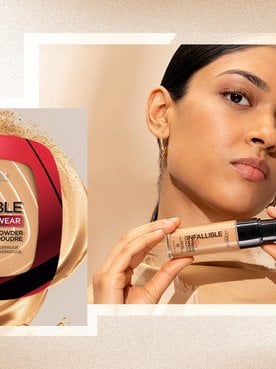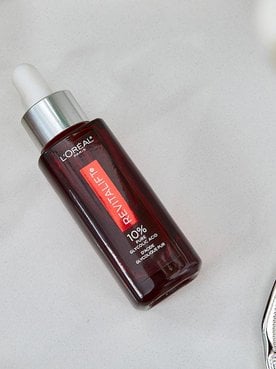When you spot someone with gorgeous, glowing skin, it’s only natural to want to ask for all their skincare secrets. But even without asking, we can wager a guess that physical and/or chemical exfoliation is involved. Exfoliating is the process of sloughing off dead skin cells from the surface of the skin, and it’s among the most effective ways to score a smooth, dewy complexion.
There are two main types of exfoliation—chemical and physical—each of which comes with its own set of benefits. Here, we’re breaking down the differences between both and shouting out our best chemical exfoliants worth adding to your routine. Soon, you’ll be the one with the swoon-worthy skin.
What Is Exfoliating and Why Does It Matter?
According to the American Academy of Dermatology (AAD), exfoliating is the process of intentionally removing dead skin cells from the outermost layer of your skin. Normally, when skin cells die, they shed on their own. This natural process helps make room for new, healthy skin cells. However, with age, the rate at which your skin turns over slows, which can make the skin appear dull, rough, or uneven. Exfoliating—either with a physical or chemical exfoliant—can help assist your skin’s natural shedding process and promote a brighter, smoother, more even-looking complexion.
What Is Chemical Exfoliation?
Chemical exfoliation involves using exfoliating acids or enzymes to help break down dead skin cells lingering on the skin’s surface. Once dissolved, these dead cells can be rinsed away to reveal a brighter, smoother-looking complexion. There are several different types of chemical exfoliants used in skincare, from ultra-mild enzymes to stronger acids used to resurface the skin. Below, we’re breaking down the most common types of chemical exfoliants.
Alpha-hydroxy acids (AHAs)
Alpha-hydroxy acids are a class of water-soluble acids that help refine and exfoliate the skin. There are many different types, but glycolic acid, lactic acid, and mandelic acid are among the most common AHAs used in skincare. According to the United States Food and Drug Administration (FDA), products formulated with AHAs can help smooth out the look of fine lines and wrinkles and improve skin texture and tone. The FDA notes that the extent of the effectiveness of these products will depend on the concentration of the AHA(s), the pH, and the other ingredients in the formula.
Beta-hydroxy acids (BHAs)
When people refer to BHAs, they’re generally referring to salicylic acid. Products with this oil-soluble ingredient can help remove dead skin, reduce excess sebum, and clear clogged pores. As such, it’s commonly found in products designed for those with oily or acne-prone skin. However, as the Cleveland Clinic notes, products with salicylic acid can also help improve skin texture and tone in those with rough or uneven-looking skin.
Polyhydroxy acids (PHAs)
Polyhydroxy acids are structurally similar to AHAs but have a larger molecular size. Like AHAs, they’re typically used in skincare products to help smooth, brighten, and refine the skin. However, due to their larger size, PHAs penetrate the skin less deeply than traditional exfoliating acids. As such, they tend to be gentler on the skin, making them a great option for those with sensitive skin.
Enzymes
Exfoliating acids tend to get all of the attention, but enzymes are another option for chemical exfoliation. These naturally derived compounds help support the skin’s natural exfoliation process to promote brighter, clearer-looking skin. Some research suggests that enzymes may be a gentler alternative to AHAs and BHAs, making them another option to consider if you have sensitive or easily irritated skin.
What Is Physical Exfoliation?
Also referred to as “mechanical exfoliation,” physical exfoliation is exactly what it sounds like: The act of using a tool to physically buff away dead skin cells. The primary benefit of this approach is that it provides an instant improvement in skin texture. However, some types of physical exfoliation may be too harsh for those with sensitive skin, per the AAD. If you’re interested in using a physical exfoliant in your routine, here are a few options to consider.
Scrubs
Scrubs are skincare products made with gritty materials that help to slough away dead skin cells. Facial scrubs typically contain small particles, like finely-milled seed powders, to gently buff away dead surface skin cells. Body scrubs, meanwhile, often utilize larger particles, such as salt or sugar crystals, to help smooth and soften rough, dry patches.
Dry brushing
Dry brushing is a popular way to enjoy some physical exfoliation action. This process requires you to rub a large bristle brush onto dry skin. The bristles help loosen up and sweep away dead skin cells to smooth and soften the skin. Dry brushing is typically reserved for the body, though there are gentler exfoliating brushes designed for use on the face, too.
Washcloth
While washcloths are usually intended for simply getting clean, they can also help exfoliate the skin’s surface. There are even some washcloths specifically meant for exfoliation—these tend to be a bit more textured than their finely-woven counterparts (the rougher texture helps whisk away stubborn dead skin cells). Just be sure to read the instructions thoroughly before using an exfoliating cloth on your face, because some may be too rough for the delicate facial skin.
Chemical vs. Physical Exfoliation: Which Is Better?
Both chemical exfoliation and physical exfoliation can help to support a smoother, brighter, and clearer-looking complexion. Neither is inherently better than the other—it’s simply a matter of personal preference.
If you have thick or oily skin, you may find that physical exfoliation provides the immediate skin-smoothing results you’re looking for. On the other hand, if your skin is sensitive or dry—or you’re hoping to address age-related concerns like fine lines or dark spots—chemical exfoliation may be a better option for you. You can even keep both on hand and use them interchangeably to target different skin concerns. With that being said, if you aren’t sure which exfoliant is right for you or how to get started, we suggest speaking with a board-certified dermatologist. They can help you identify which approach is best for your skin.
Regardless of which approach you choose, it’s crucial to use sunscreen after exfoliating, as exfoliation can make your skin more sensitive to the sun’s damaging rays. Opt for a broad-spectrum formula with an SPF of at least 30 and apply it at least every two hours (more frequently if you’re sweating or swimming). We love the L’Oréal Paris RevitaLift Triple Power Moisturizer with SPF 30, as it’s packed with anti-aging ingredients and helps firm, brighten, and smooth the skin while protecting it against damaging UV rays.

Shop the Product
4 of Our Best Chemical Exfoliators
If you’re ready to incorporate an exfoliating step into your routine, you’ve come to the right place. Below, we’re spilling the details on four of our favorite chemical exfoliants for smooth, glowing skin.
L’Oréal Paris Bright Reveal Dark Spot Exfoliant Peel
We’ll kick off this list with our favorite facial exfoliant for brighter, more even-looking skin: The L’Oréal Paris Bright Reveal Dark Spot Exfoliant Peel. This potent yet gentle formula is inspired by professional peels and contains a targeted blend of AHAs, BHAs, and PHAs to help refine and resurface the skin. After one use, you’ll notice your skin looks brighter and feels smoother, while continued use helps visibly fade the look of dark spots, including post-acne marks and sun spots. Plus, it’s suitable for all skin types and tones, making it an excellent pick for anyone looking to add an exfoliating step to their routine. We recommend using it no more than four times per week (at night) for the best results.

L’Oréal Paris RevitaLift 10% Pure Glycolic Acid Serum
Formulated with 10% pure glycolic acid, this age-defying exfoliating serum gently yet effectively targets signs of aging, including uneven skin tone, fine lines and wrinkles, dark spots, and dullness. You’ll see a notable difference in your skin’s texture after one week of consistent use, and over time, you’ll enjoy a visible improvement in the appearance of dark spots and lines.
L’Oréal Paris RevitaLift 12% Pure Vitamin C + E + Salicylic Acid Serum
Gently exfoliate your skin while targeting dullness and unevenness with this daily-use facial serum. The gentle formula contains vitamin C alongside exfoliating salicylic acid and helps target three key signs of skin aging to promote a more radiant, youthful-looking complexion over time.

L’Oréal Paris RevitaLift Radiant Smoothing Cream Cleanser
If you don’t want to add a separate exfoliating step to your routine but still want to reap the benefits of chemical exfoliation, consider using an exfoliating cleanser. This one, which contains salicylic acid and vitamin C, is a great pick for all skin types—and it’s gentle enough to use morning and night.
Shop the Products
Next Up: How To Use an Exfoliating Face Mask or Peel
Photo courtesy of L’Oréal Paris







